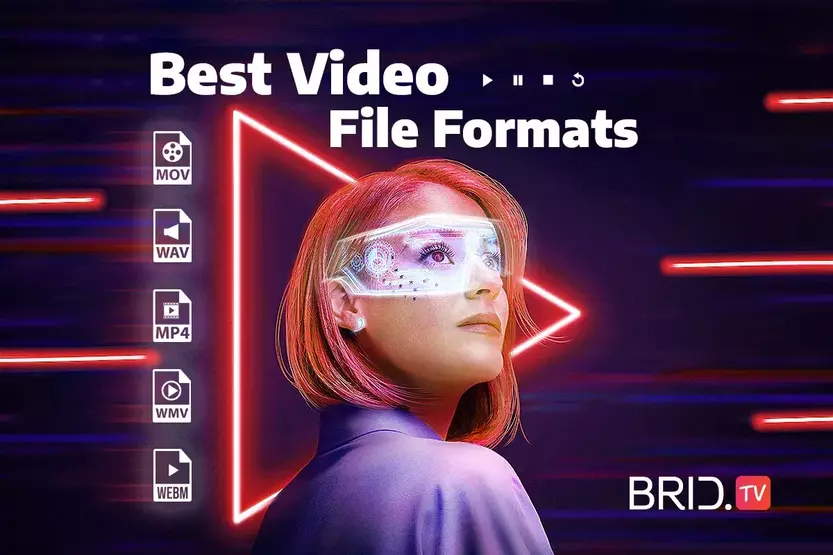With so many different options out there, choosing the best video file format for your clips can be a daunting task. But don’t worry — we’ve got you. In this article, we bring you the best video file formats in 2023 — along with what they’re actually best for. Whether you’re planning to launch a VOD streaming service or just need a way to store a large number of videos without taking up too much space, you will soon know exactly which video format to use.
What Is a Video File Format and How Does It Work?
A video file format is a format used to store digital video data on a computer. Extensions found after the name of the file show us which format the video is stored in. This might also dictate which software will be able to open and play the video (and whether you will have to transcode the video in order to play it). There are dozens of different formats out there, and not all of them are suitable for all purposes. But to know which video file format is the best one for your video, it is important to understand how video file formats work. In order to do that, we need to get familiar with two key terms — codecs and containers.
What Is a Container in a Video File Format?
A video file container is, quite literally, a container that carries all the data pertaining to the video. This includes both the visual and the audio components, as well as some metadata, such as the time and place the video was taken, the equipment used to film, video SEO information, and the title of the video. In fact, when we talk about video file formats, we are mostly talking about containers (although this is not always the case). An example of a video file container you are likely familiar with is .mp4.
What Is a Codec in a Video File Format?
Codec is a piece of software used for encoding and decoding a video. In fact, the word codec comes from coder and decoder. Simply put, the coder part of the codec compresses the video file to make it easier to store or send. On the other hand, the decoder part is in charge of making a compressed file usable again by decoding it. There are many different video codecs out there, but some of the most commonly used ones are H.264 and H.265.
What Is the Difference Between a Codec and a Container in Video Files?
The difference between a codec and a container in video files is the role they play in file storage and distribution. Although both codecs and containers are vital elements in a video file, they serve completely different purposes. In short, the container is a box in which all the data is stored, and the codec is a piece of software that makes the file smaller or larger.
If this sounds a little too confusing, try imagining that you are packing winter clothes in a vacuum bag. The clothes themselves are the video data. The bag would be the container, and the vacuum you use to suck the air out of the bag is the codec. In order to be able to store all your clothes on a shelf, you need to make them as compact as possible (that is, encode the video to store it on a computer). And once you decide to wear them again (that is, play the video), you need to let the air back into the bag (you need to decode the video to play it).
8 Best Video File Formats in 2023
Now that we’ve gone over the basics of what video formats are and how they work, let’s take a closer look at some of the most commonly used ones. Although there are many video file formats out there, the most commonly used ones include:
- mp4
- WebM
- mov
- avi
- mkv
- wmv
- avchd
- flv
1. MP4

MP4 is by far one of the most commonly used video file formats. It is highly versatile and compatible with a wide array of players and devices (including TargetVideo’s HTML5 player). First released in 2001, MP4 is considered to be a global standard for video encoding today. It provides a high level of compression (that is, it can make the video file much smaller) without significantly affecting the quality of the video.
Pros:
- Compatibility with a long list of media players;
- Compatibility with a wide array of video-sharing websites, including YouTube;
- High compression without a lot of quality deterioration.
Cons:
- Encoding, playing, and editing an MP4 video require quite a bit of computing power;
- MP4 makes it quite easy to alter the metadata of a file and illegally distribute content;
- Repeat encoding can lead to significant quality deterioration, as MP4 is a lossy format.

2. WebM

WebM is an open-source format developed by Google. It was mainly created for the purpose of sharing video files online and is supported by all major browsers, from Google Chrome to Microsoft Edge. As it contains small video files, it allows for almost immediate playback, making it great for websites with a lot of video content and one of the go-to options for live streaming platforms such as Streamlab.
Pros:
- Small file sizes call for low computational power;
- It is an open-source format available to everyone;
- Offers great quality real-time video delivery, making it great for live streaming;
- Compatible with major online video platforms, such as YouTube.
Cons:
- Not the best compatibility with mobile devices;
- Might not be compatible with some players and browsers, especially older ones.
You Might Also Like: Best Live Streaming Equipment for All Budgets (2023 Edition)
3. MOV

MOV is a video file format that is most compatible with iOS devices, although it also works on Windows. It was developed by Apple with the main purpose of storing full-length movies. It supports high video bitrate, which also enables decent video quality. MOV is compatible with a long list of codecs and platforms. The best players to use to open MOV files are QuickTime and VLC.
Pros:
- Offers great video quality;
- Can contain different multimedia elements, such as video, audio, or text, stored as separate tracks;
- Compatible with a wide array of codecs and platforms, including YouTube, Facebook, and Instagram.
Cons:
- Large file sizes;
- Poor compatibility with players other than QuickTime or VLC;
- Compatibility with Facebook and Instagram is limited to files of up to 4GB.
Partner Article You Might Also Like: Best Professional Video Cameras
4. AVI

Microsoft developed the AVI format in 1992, making it one of the oldest video formats. Along with MP4, it is also one of the most common video formats out there. It is compatible with all devices that use Windows, Mac, or Linux and with all major internet browsers. It is one of the most common formats for TV, which might account for its popularity slightly dropping in recent years.
Pros:
- Compatible with most players, browsers, and platforms;
- Offers high-quality video and audio;
- Suitable for short videos, promos, advertisements, teasers, etc.
Cons:
- It requires more storage than most other video file formats;
- Not a good option for live streaming videos;
- Compression with quality retention is not its strongest suit.
5. MKV

MKV got its name after Matroskas — Russian stacking dolls. And that is exactly what MKV is — a video file format that can contain an unlimited number of video or audio tracks within it. For example, if a clip has several audio options in different languages, MKV will store each option as a separate track. It also supports elements such as chapters or menus.
Pros:
- Free and open-source, meaning that it is constantly being updated and improved;
- It supports almost all codecs out there;
- It is a universal container that supports unlimited tracks, menus, chapters, and more.
Cons:
- Not compatible with many players and devices;
- Uses a more complicated compression process than most other formats;
- MKV file sizes are relatively large.
6. WMV

WMV format is perfect for storing large amounts of video and audio data without taking up too much space. It has a high compression ratio with the ability to retain relatively good video quality. WMV was developed by Microsoft. As such, it is compatible with Windows Media Player and other Windows-based programs. Still, its compatibility with other operating systems and programs is pretty low. Unlike many other formats, WMV can serve both as a container and as a codec. Files stored in this format are often protected by Digital Rights Management systems.
Pros:
- It can store a lot of data without taking up too much space;
- The compression ratio is twice as high as for MPEG-4;
- It is fully compatible with Windows, including older software such as Microsoft PowerPoint.
Cons:
- Compatibility with other operating systems and programs is quite limited;
- The compression ratio is not manually adjustable;
- Due to limited compatibility, it is hardly a standard video file format.
7. AVCHD

AVCHD was a joint venture by Sony and Panasonic as a format for video production using digital cameras and camcorders. It is the format that allows for the highest quality of videos, and its newest edition also supports 3D videos. It includes highly efficient encoding using the H.264 codec without significant quality loss.
Pros:
- Highest-quality video files;
- 3D video support;
- Compatibility with Blu-ray and memory cards;
- Compatibility with Sony, Panasonic, and Canon cameras.
Cons:
- Files saved in this format are quite large;
- Compatibility with various devices and programs is relatively limited;
- Editing this format can be quite complicated and time-consuming.
You Might Also Like: How to Make the Best Professional Video Studio Setup on Any Budget
8. FLV

FLV is a video file format designed for Adobe Flash Player. However, since Adobe discontinued its support for the player in December 2020, many VOD providers have been moving away from it in favor of the HTML5 video player. Along with the Flash Player, FLV has been slowly dying, too. Adobe, for example, recommends replacing it with the H.264 codec.
Back in its glory days, FLV used to be one of the go-to file formats for basically anyone (except iOS users). However, it has become relatively obsolete nowadays. Although there are still online video players and platforms out there that support the FLV format, it is likely that any software developed in the future will not be compatible with it, so it might be a good idea to go for a different option.
How to Pick the Best Video File Format
So we’ve covered the basics of the top video file formats in 2023. But which one is the best? Unfortunately, there is no clear-cut answer to this question. Are you launching an OTT service, planning to add a couple of videos to your website, or just want to e-mail some clips from your last vacation to a friend? The choice of the best video format will depend on what exactly you’re planning to do with the videos, so here is a quick overview of what makes each of these formats stand out:
- MP4 is a universal format that is supported by all major operating systems, browsers, and players. It is the safest option for maintaining decent video quality without sacrificing too much storage space.
- WebM is a great option for online libraries and live streaming, especially on Windows devices.
- MOV is most compatible with iOS devices and is a great option for full-length movies.
- AVI maintains a high quality of video and audio and is compatible with most browsers, systems, and platforms. However, due to its high storage requirements, it is most useful for short clips.
- MKV is a unique format in terms of its unlimited track-storing capabilities. It is the right choice for videos with multiple audio options, chapters, menus, and similar elements.
- WMV is the right choice if you want to save up on space, as it has a very high compression ratio. However, its range of compatibility with operating systems other than Windows is quite narrow.
- Lastly, AVCHD is the format used by professional recording equipment to store data. It maintains a very high quality of video files, although it takes up quite a lot of space.
Video File Formats: An Overview
As you can see, options are plentiful. To make the choice of the right format easier, here’s a quick overview of what each of the formats above is best for.
| File Format | Best Used For |
|---|---|
| MP4 | Universal format, good for uploading decent-quality videos to streaming platforms such as YouTube or Facebook and storing video files on computers and phones |
| WebM | Online video libraries and live streaming |
| MOV | Full-length movies, especially on iOS |
| AVI | Short clips, promotional videos, advertisements |
| MKV | Videos with multiple audio options, a large number of separate tracks, selectable chapters and menu options |
| WMV | Videos with multiple audio options, a large number of separate tracks, selectable chapters, and menu options |
| AVCHD | High-quality videos recorded with professional equipment, 3D videos |
| FLV | Nostalgia |
You May Also Like: 12 Best Video Streaming Platforms for Publishers and Broadcasters
Let’s Wrap Up: Choosing the Best Video Format
We know all of this can be a little confusing, especially if you’re new to the video industry. And sure, choosing the right video file format is no easy task, but luckily, there are some things you won’t have to worry about. No matter which format you decide to go for, you can count on TargetVideo’s HTML5 player, as it is compatible with most video file formats out there.
You won’t have to worry about choosing the right video streaming protocol or finding ways to implement adaptive bitrate streaming — our player handles that for you. And if you’re planning on becoming the next live streaming superstar, we also support HTTP live streaming with both European and American servers.
Try out our low-latency, lightweight HTML5 player for free.

FAQ
1. What is the best video file format?
MP4 is the best video file format, at least if we go by the sheer number of its users. As it is compatible with all major browsers, operating systems, platforms, and players, there is little chance that you won’t be able to upload it somewhere. It is considered to be a universal standard for video formats as it preserves relatively good video quality without taking up too much storage space.
2. What is the best video file format for the web?
MP4 and WMV are the best video file formats for the web, as they don’t take up too much space and are compatible with most browsers.
3. What is the best video file format for video quality?
AVCHD and MOV formats are the best video file formats in terms of video quality. However, keep in mind that files saved in these formats tend to take up a lot of storage space.
4. What is the best video file format for video streaming?
WebM is considered to be one of the best video file formats for OTT, video-on-demand, or other online purposes. However, as long as the format you choose supports H.264 encoding, you shouldn’t have any issues.
5. What is the best video file format for 4K video?
MP4, AVCHD, and MKV are the best video file formats for 4K videos, although they are not the only options. The final choice will likely depend on the storage space available or the compression rate you are willing to allow.
6. What is the best video file format for YouTube?
MP4 is the best video file format for YouTube, although the platform supports a long list of other formats, such as MOV, AVI, WMV, WebM, and even FLV, to name a few. Even if your video is in an unsupported format, such as MSWMM, WLMP, or PIV, the platform will transcode it for you.
7. What is the best video file format for Facebook?
MP4 is the best video file format for Facebook. However, the platform supports many other video formats, from mobile ones, such as 3GP, to MKV, AVI, and WMV.
8. What is the best video file format for Instagram?
MP4 and MOV are the best video file formats for Instagram. They are some of the very few formats the platform supports, as many popular formats are not supported, such as AVI, WMV, and MKV.
9. What is the best video file format for Twitter?
MP4 and MOV formats are the best video file formats for Twitter. In fact, they are the only two formats supported by the platform. If you are uploading a video to Twitter using the platform’s mobile app, you can do so with either one. But if you are uploading from a computer, your file will have to be in the MP4 format.
